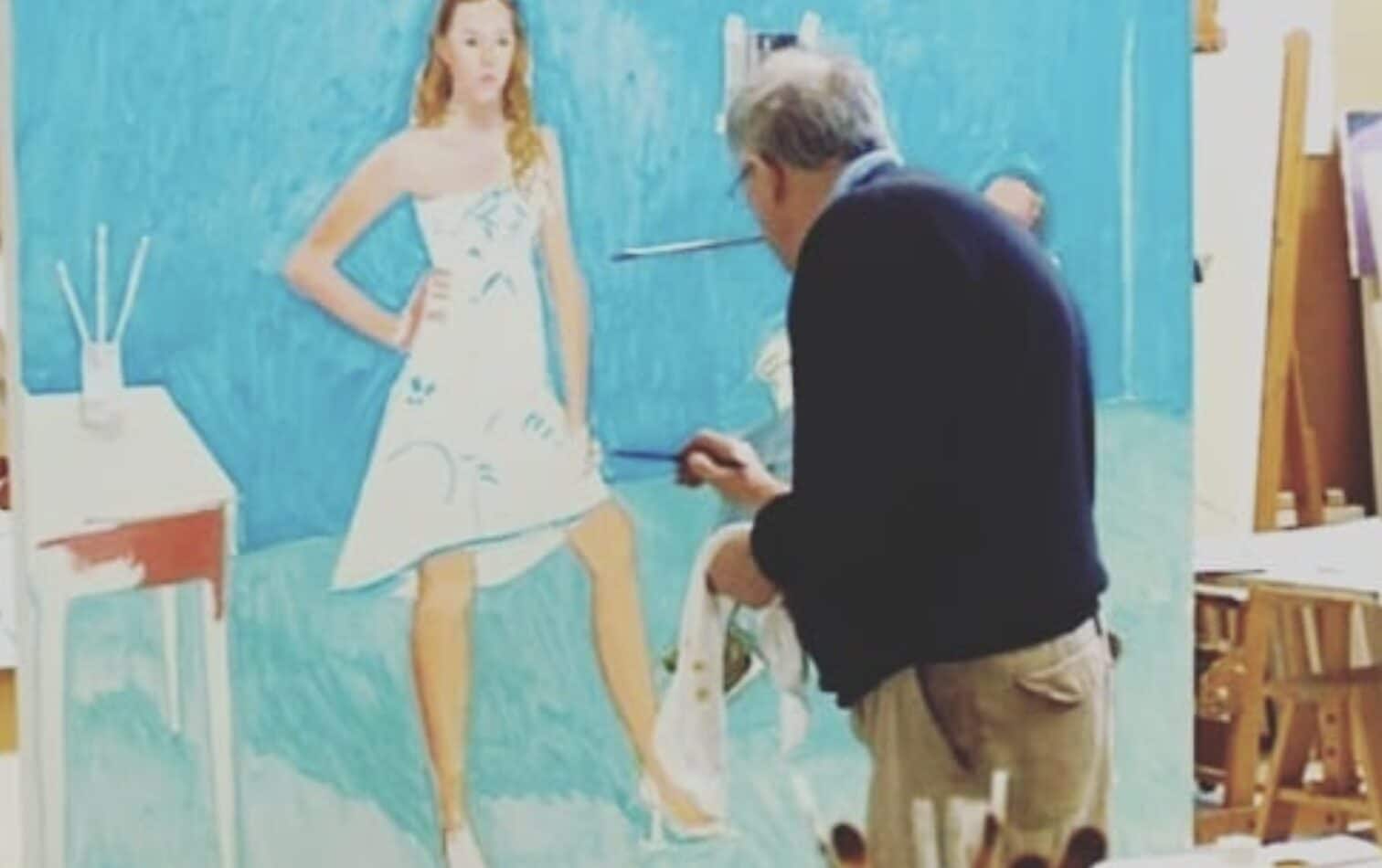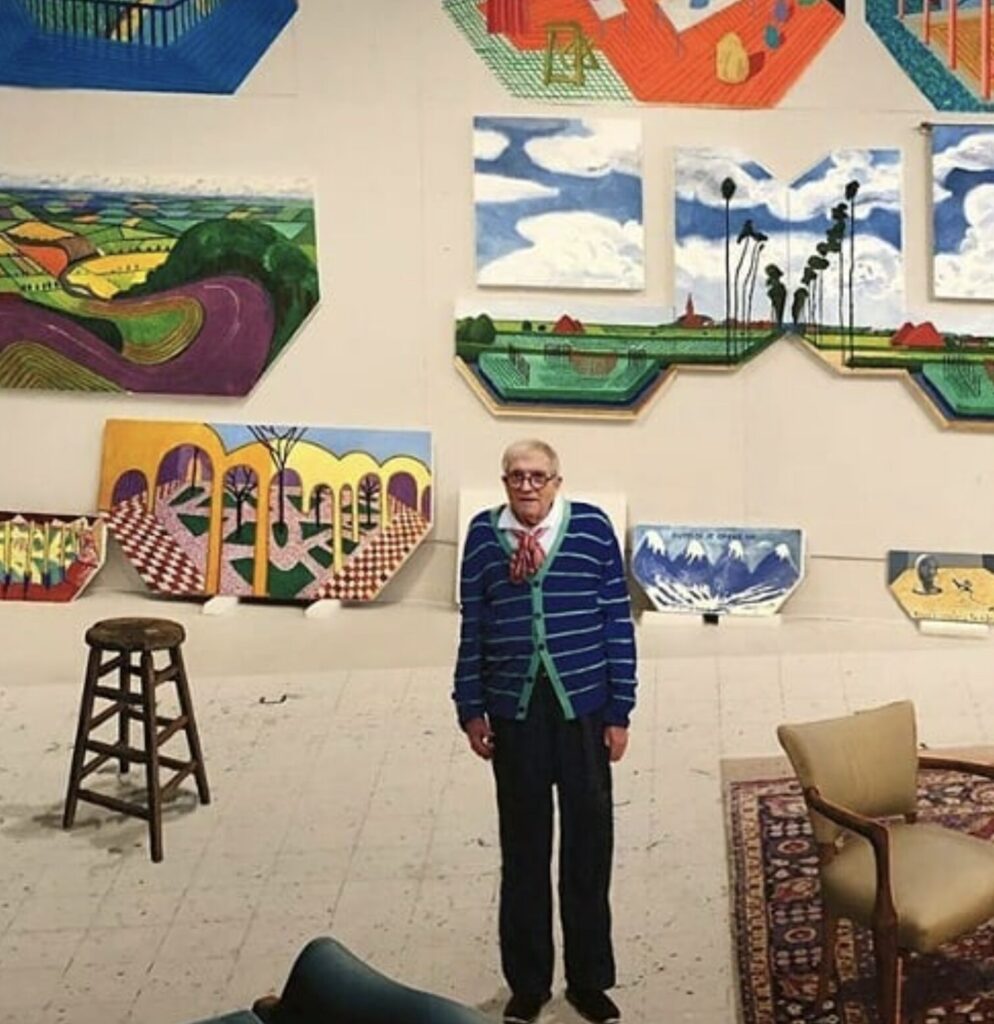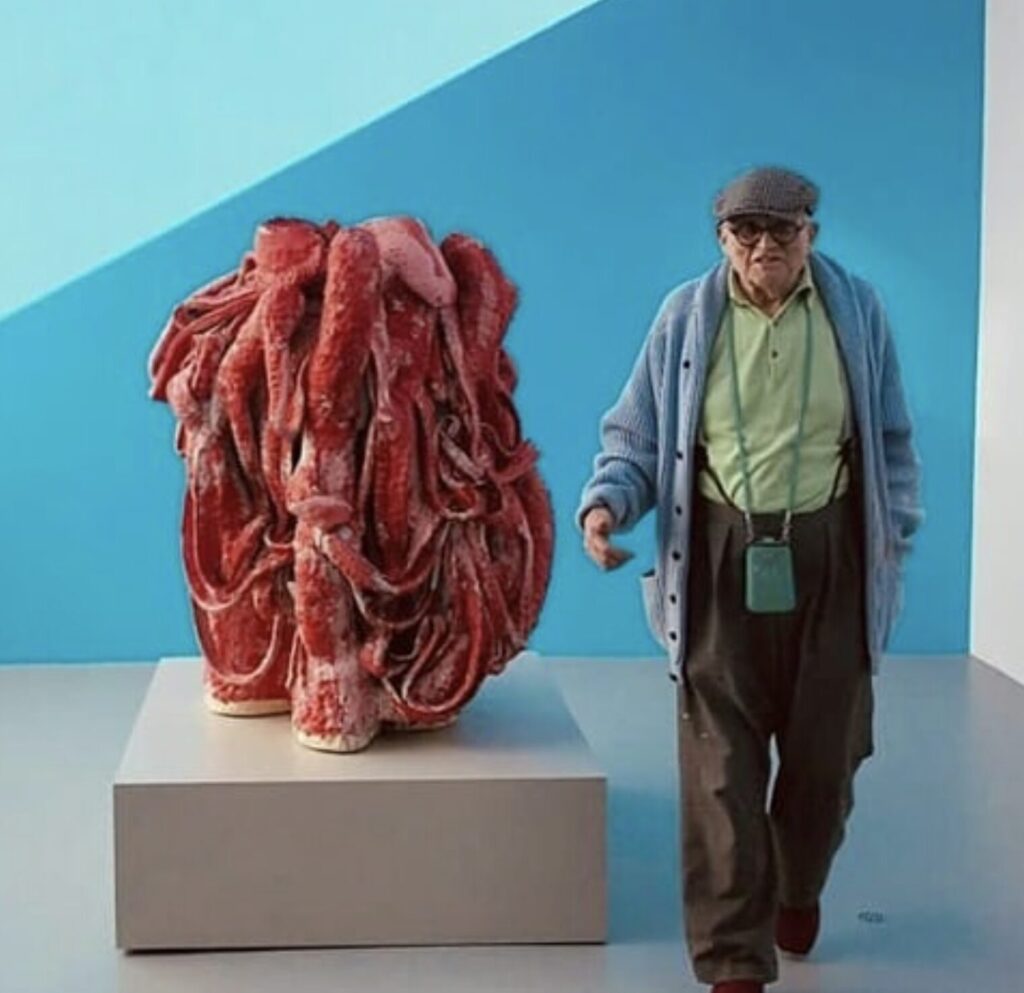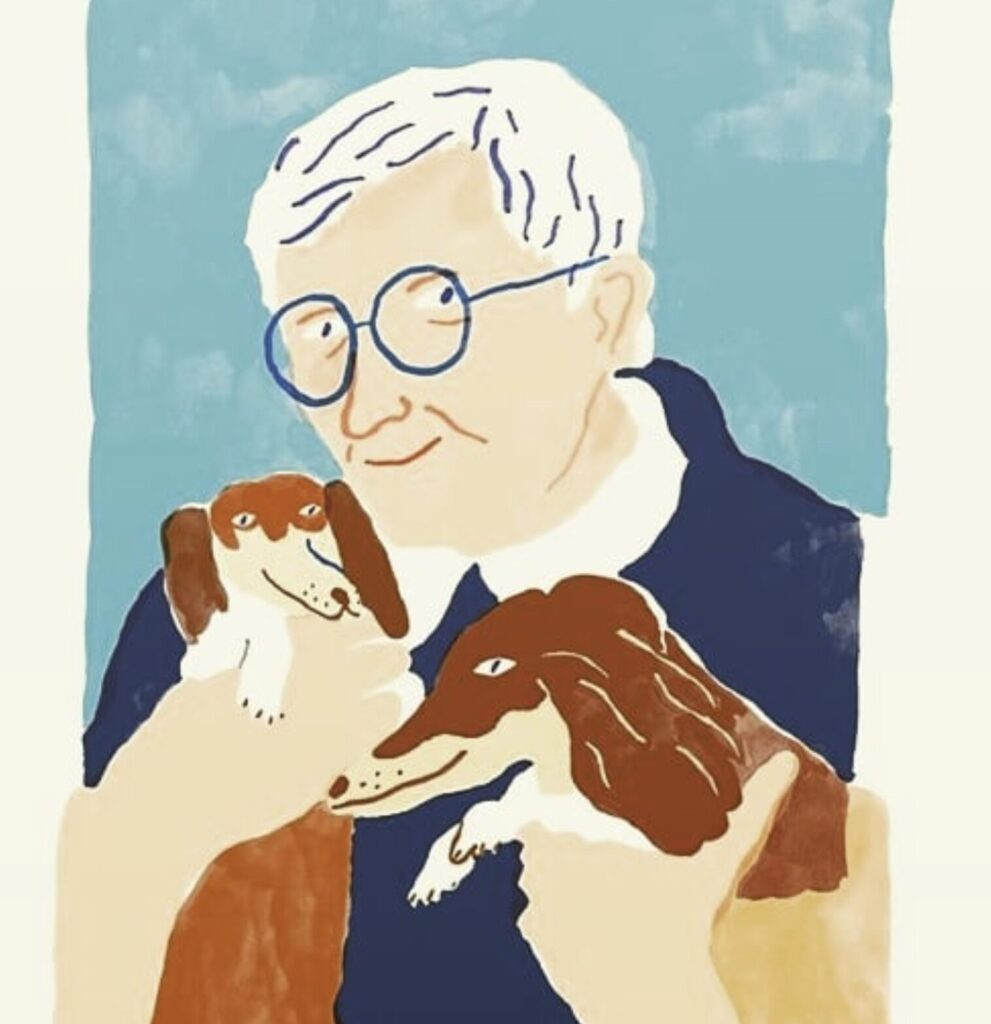Physical Address
304 North Cardinal St.
Dorchester Center, MA 02124
Physical Address
304 North Cardinal St.
Dorchester Center, MA 02124

David Hockney stands as one of Britain’s most celebrated artists, but his paintings offer more than just visual beauty. His artworks serve as a vivid autobiography, chronicling his personal journey from a young man in Bradford to an internationally acclaimed artist whose life experiences shaped every brushstroke. David Hockney’s most famous works span six decades and reveal intimate details about his relationships, travels, and evolving artistic vision.
The connection between Hockney’s life and art becomes clear when examining his subject matter. His early works reflect his Yorkshire roots and art school experiences, while his famous pool paintings capture his fascination with California’s lifestyle and culture. His loved ones and loving partners turn up repeatedly in his works, creating a visual diary of his most meaningful relationships and personal connections.
From his breakthrough in the Pop Art movement to his recent digital experiments, each phase of Hockney’s career mirrors significant life changes. His paintings document not just artistic evolution but personal growth, relationships, travels, and the passage of time. This makes his body of work uniquely readable as both art history and personal memoir.
David Hockney’s paintings function as visual chapters of his personal narrative, revealing his journey through identity, sexuality, and relationships. His canvases document intimate moments, family connections, and the evolution of his artistic voice across decades of creative expression.

Hockney’s exploration of identity permeates his work from his earliest paintings. As a gay artist emerging in the 1960s, he used his canvases to navigate questions of sexuality and belonging in a society that often marginalized LGBTQ+ individuals.
His self-portraits reveal different phases of his personal evolution. Early works show a young artist finding his voice. Later paintings demonstrate confidence and self-acceptance.
The British artist frequently painted scenes that reflected his internal conflicts and discoveries. His move from industrial Bradford to vibrant California marked a pivotal transformation captured in his art.
Color choices in his paintings often mirror his emotional states. Bright, saturated hues emerged as he found greater personal freedom. Darker tones appeared during periods of uncertainty or loss.
His artistic style shifts parallel major life changes. The transition from realistic portraits to more experimental techniques coincided with his growing confidence as both an artist and individual.
Hockney transforms ordinary moments into profound personal statements through his drawing and painting techniques. Each brushstroke carries emotional weight beyond mere visual representation.
His famous pool paintings capture more than California leisure culture. They represent his newfound freedom and the joy of living authentically in a supportive environment.
The English painter uses symbolism throughout his work to communicate personal experiences. Water often represents cleansing or renewal. Architecture symbolizes stability or confinement depending on the context.
His choice of subjects reflects his inner world. Landscapes from his Yorkshire childhood appear when he feels nostalgic. Urban scenes emerge during periods of social engagement.

Technical innovations in his work mirror personal breakthroughs. His experiments with perspective coincided with new ways of seeing himself and his relationships.
Hockney’s portraits serve as visual diaries of his closest relationships. His intimate portraits of friends, lovers, and family members reveal the depth of his personal connections.
His painting of his parents sitting in their living room captures family dynamics with remarkable honesty. The positioning and expressions reveal unspoken tensions and enduring love.
Portraits of romantic partners document the progression of relationships. Early paintings show idealization and passion. Later works often reveal complexity or distance as relationships evolved.
The artist frequently painted his circle of friends and collaborators. These works create a visual record of his community and support network throughout different life phases.
His group portraits function as personal exploration through art, showing how relationships shaped his artistic development. The positioning of figures reveals social hierarchies and emotional connections within his world.
David Hockney’s formative years in industrial Yorkshire and his educational journey through Bradford’s institutions laid the groundwork for his revolutionary artistic vision. His progression from local art school to London’s prestigious Royal College of Art shaped both his technical skills and his bold approach to personal expression.
Bradford provided Hockney with a working-class perspective that would influence his art throughout his career. Born in 1937, he grew up in an industrial town where his father worked as an accountant and his mother was a Methodist.
The Yorkshire landscape offered Hockney his first artistic subjects. Rolling hills and textile mills became early motifs in his sketches and paintings.
His family encouraged creative expression despite their modest means. Hockney began painting at age 11, showing natural talent that his parents recognized and supported.
The contrast between Bradford’s industrial grit and the surrounding countryside gave Hockney an appreciation for both urban and natural environments. This duality would later appear in his California pool paintings and English landscape works.

At Bradford Grammar School, Hockney studied alongside future collaborators including Norman Stevens and John Loker. These friendships formed the foundation of his artistic network.
The school’s art department provided structured training in traditional techniques. Hockney learned figure drawing, color theory, and composition fundamentals that anchored his later experimental work.
In 1953, he enrolled at Bradford School of Art for two years of intensive study. The curriculum emphasized practical skills and commercial applications of art.
David Oxtoby, a fellow student, became both friend and artistic influence during this period. Their shared interest in pushing artistic boundaries created a supportive creative environment.
The school exposed Hockney to modern art movements through reproductions and visiting lectures. Abstract Expressionism and early Pop Art concepts began shaping his artistic philosophy.
Hockney arrived at the Royal College of Art in London in October 1959 at age 22. The transition from provincial Bradford to cosmopolitan London marked a crucial turning point in his development.
The college’s progressive atmosphere encouraged experimentation with new media and subjects. Hockney’s early works from this period reveal a playful, rebellious spirit filled with graffiti-like scribbles.
He won the Jinles Prize during his studies, establishing his reputation among peers and faculty. This recognition validated his unconventional approach to traditional subjects.
The Royal College connected Hockney with London’s emerging art scene. Gallery visits, particularly the 1960 Picasso retrospective at the Tate, profoundly influenced his artistic direction.
David Hockney’s rise during the 1960s established him as a leading figure in British pop art, distinguished by his vibrant colors and personal approach to contemporary themes. His early works combined traditional techniques with modern subject matter, earning him prestigious recognition including the John Moores Painting Prize and later appointment as a Royal Academician.
Hockney emerged as a key figure in the British Pop Art movement during the 1960s London art scene. Unlike American pop art’s focus on consumer culture, Hockney developed a more personal and introspective approach.
His work was characterized by bold, vibrant colors and an unmistakable sense of energy that captured the era’s youthful spirit. While contemporaries like Andy Warhol explored mass production themes, Hockney focused on intimate relationships and personal experiences.
He brought emotional depth to the pop art movement. His paintings explored themes of love, identity, and sexuality with unprecedented openness in the art world.
Key Characteristics of Hockney’s Pop Art Style:
Hockney’s breakthrough came with his swimming pool paintings in California. A Bigger Splash (1967) became one of his most recognized works from this period.
This painting demonstrated his innovative approach to modern art. The work captured a frozen moment of water splashing in a California pool, combining photographic realism with graphic simplicity.
His “joiners” series marked another significant innovation. These photographic collages used multiple Polaroid images to create fragmented, overlapping perspectives that challenged traditional single-point perspective.
Portrait of an Artist (Pool with Two Figures) (1972) exemplified his mature style. The painting combined his California pool motif with complex emotional undertones about relationships and separation.
These works established Hockney’s reputation for merging traditional media with new technologies and unconventional techniques.
Hockney’s talent gained early recognition through prestigious awards and honors. He won the John Moores Painting Prize in 1967, cementing his status in British contemporary art.
His election as a Royal Academician in 1991 acknowledged his significant contributions to British art. This honor recognized both his artistic innovation and influence on younger generations of artists.
The ultimate recognition came with his appointment to the Order of Merit in 2012 by Queen Elizabeth II. This rare honor is limited to 24 living members and recognizes exceptional achievement in arts, learning, literature, and science.
Timeline of Major Recognition:
Critics praised his ability to make pop art more personal and emotionally resonant. His work bridged the gap between traditional portraiture and contemporary pop art sensibilities.
Hockney’s 1964 move to Los Angeles transformed both his artistic vision and personal narrative. The bright California sun, private swimming pools, and American lifestyle became central themes that would define his most celebrated works.
When Hockney arrived in LA in 1963, he fell in love with the city’s promise of freedom and endless sunshine. The contrast from Bradford’s industrial landscape to California’s vibrant culture marked a pivotal chapter in his life story.
Growing up in Yorkshire, Hockney had been fascinated by Hollywood films and American magazines like Physique Pictorial. These images shaped his romantic vision of California long before he experienced it firsthand.
Key American influences on Hockney:
The artist recognized Los Angeles as uncharted territory that he could conquer as a painter. He famously declared the city needed its own artistic chronicler, positioning himself as LA’s visual historian.
Swimming pools quickly became his sign for California, representing luxury that seemed impossible to a British artist who lived through wartime rationing. These aquamarine rectangles told the story of his new American life.
His first pool painting, California Art Collector (1964), depicted the sophisticated world of American collectors like Fred and Marcia Weisman. The work showed fashionable collectors in their gardens, surrounded by art and the California lifestyle Hockney was documenting.
Famous pool paintings include:
The pools represented more than luxury. They symbolized sexual freedom, hedonism, and the openness Hockney found in American culture. Each painting captured moments of his social circle enjoying California’s perpetual summer.
Hockney’s later works expanded beyond pools to capture the broader California landscape. He painted the Hollywood Hills’ winding roads and the dramatic coastline from Malibu to the Pacific Coast Highway.
His monumental landscape Pacific Coast Highway and Santa Monica represents the pinnacle of his longstanding visual infatuation with Los Angeles. The painting chronicles his mature relationship with the city that had become his permanent home.
The artist’s Beverly Hills studio became a gathering place for celebrities, collectors, and fellow artists. His paintings documented pool parties, intimate gatherings, and quiet moments in this glamorous world.
Geographic areas featured in his work:
These landscapes weren’t just pretty pictures. They mapped Hockney’s emotional and physical journey through American life, showing how completely he had embraced his adopted homeland.
Hockney’s portraits reveal his deepest connections through carefully composed paintings of lovers, friends, and family members. His innovative double portraits capture intimate moments between couples, while his depictions of close friends and artistic collaborators document the relationships that shaped his creative journey.
Hockney revolutionized portrait painting through his intimate double portraits of couples. His famous “Mr. and Mrs. Clark and Percy” (1970-71) shows fashion designer Ossie Clark and textile designer Celia Birtwell in their London flat with their cat Percy.
The painting captures domestic life with careful attention to body language and spatial relationships. Celia stands while Ossie sits, creating visual tension that reflects their personalities.
Hockney’s double portraits are unique due to their intimate portrayal of personal relationships and innovative approach to contemporary realism. These works show couples in natural settings rather than formal poses.
“We Two Boys Together Clinging” represents another approach to depicting intimacy. The painting explores male relationships through Hockney’s personal lens as an openly gay artist.
His double portraits often feature asymmetrical compositions where figures occupy different levels or positions. This technique creates visual interest while suggesting psychological dynamics between subjects.
Hockney’s circle of friends and family members appear repeatedly throughout his work. Portraits of family and friends show the artist’s mother, Laura Hockney; textile designer Celia Birtwell; his friend and former curator Gregory Evans; and printmaker Maurice Payne.
His mother Laura appears in numerous paintings and drawings over decades. These works document their close relationship and her aging process through Hockney’s compassionate eye.
Celia Birtwell features in multiple works beyond the Clark portrait. From the luminous gaze of Celia Birtwell to other intimate depictions, she represents a lasting friendship in his art.
Key portrait subjects include:
Hockney’s extensive catalogue of portraiture shows his extraordinary ability to capture the essence of his subjects. Each face tells a story rich in emotion and personal connection.
Hockney’s relationships with fellow artists shaped his portrait work significantly. His connection to Francis Bacon influenced his approach to depicting the human figure with psychological depth.
Peter Blake, another British pop artist, shared Hockney’s interest in contemporary culture and portraiture. Their friendship provided artistic dialogue that enriched both artists’ work.
Peter Schlesinger played a crucial role as both romantic partner and artistic subject. For David Hockney, love is the origin of all creativity and art, which is why his loved ones and loving partners turn up repeatedly in his works.
Schlesinger appears in multiple paintings including pool scenes and interior portraits. Their relationship lasted several years and produced some of Hockney’s most emotionally charged work.
“Model with Unfinished Self Portrait” explores the relationship between artist and subject. The painting shows how creative partnerships involve vulnerability and trust between painter and model.
Hockney’s personal life and his relationship with Peter Schlesinger add another layer of meaning to his paintings. These works can be read as meditations on love, loss, and artistic collaboration.
Hockney’s artistic journey expanded dramatically through his embrace of new technologies and photographic techniques. His revolutionary joiner photographs challenged traditional perspective while his later adoption of digital tools like iPads transformed how he approached color and composition.
Hockney initially viewed photography with skepticism, considering it too static and limited. This changed dramatically in the early 1980s when he began creating what he called “joiners.”
These works involved taking multiple Polaroid photographs or 35mm prints of a single subject from different angles. He then arranged them into a patchwork to create one composite image. One of his first photomontages featured his mother.
The joiners allowed viewers’ eyes to move through a scene like they do in real life. Each photograph captured a different moment and angle. When combined, they told a story of movement through space.
Key characteristics of Hockney’s joiners:
The joiner technique emerged accidentally while working in Los Angeles in the 1960s. He discovered that assembling Polaroids conveyed spatial movement in unexpected ways.
Hockney embraced digital technology later in his career, becoming one of the first major artists to seriously explore iPad drawing. He began using the device around 2009 to create vibrant landscapes and still lifes.
The iPad allowed him to work with pure color and light in ways traditional painting could not match. He could layer colors digitally and create effects impossible with physical paint. The portability meant he could capture scenes immediately.
He also experimented with Photoshop for creating complex collages and manipulating photographs. These digital tools expanded his ability to play with perspective and color relationships. The technology gave him new ways to explore the same themes that had always interested him.
Digital advantages Hockney discovered:
Hockney’s photographic practice drew heavily from Cubist principles. He rejected single-perspective photography in favor of fragmented, multi-angle approaches. This broke scenes into components that could be reassembled.
The influence appeared clearly in his joiners, where multiple viewpoints created depth and movement. Cubism involves breaking objects apart and reassembling them in abstract form. Hockney applied this concept to photography.
He also explored the camera obscura, an ancient optical device that projects images. This tool helped him understand how light and perspective work together. The camera obscura influenced his paintings by showing him new ways to see space and depth.
His work as a printmaker also benefited from these experiments. He worked with master printer Ken Tyler in the 1980s, creating etchings and lithographs. Later, he explored color photocopiers as another way to manipulate images and create new visual effects.
Hockney’s return to England in 2005 marked a dramatic shift from his California pool paintings to intimate depictions of Yorkshire countryside. His creative period in Bridlington between 2005 and 2013 produced some of his most celebrated landscape works, followed by his artistic exploration of Normandy from 2019 onward.
Between 2005 and 2013, David Hockney lived at Bridlington, East Yorkshire. This coastal town provided the perfect environment for his artistic renaissance.
The artist established a 10,000-square-foot studio in Bridlington. This massive space allowed him to create large-scale canvases that captured the expansive Yorkshire landscape.
Bridlington offered practical advantages for the aging artist. His increasing deafness made the quiet town more comfortable than bustling Los Angeles. Visitors had to make appointments rather than dropping in unexpectedly.
The town’s residents respected his privacy while acknowledging his celebrity status. He became a familiar figure cycling through the streets and exploring the surrounding countryside.
His connection to the area ran deep. As a teenager, he had spent two summers stacking corn on a farm in Huggate, which made him “fall in love with this part of the world.”
Hockney’s Yorkshire period produced some of his most ambitious landscape works. “Bigger Trees near Warter” became one of his signature pieces from this era.
The artist focused on tree canopy tunnels and country lanes. These compositions drew viewers into the heart of the Yorkshire Wolds landscape.
His “Arrival of Spring in Woldgate” series captured seasonal changes along a seven-mile stretch. Starting New Year’s Day 2011, he documented over 60 images showing winter snow transforming into summer’s lush green.
Key locations included:
He used both traditional painting and iPad technology. The digital works were printed at five feet high, creating monumental pieces from intimate sketches.
In early 2019, David Hockney moved to Normandy, establishing his home in the Pays d’Auge region. This relocation sparked another creative transformation in his landscape work.
The Bayeux Tapestry inspired his Normandy period. The 70-meter medieval frieze reminded him of ancient Chinese scroll paintings, influencing his approach to depicting the French countryside.
Normandy’s different light and topography challenged his artistic vision. The region’s rolling hills and distinctive architecture provided new subjects for exploration.
His current work from Normandy continues his lifelong fascination with landscape painting. At age 87, he remains actively engaged in creating new portrait and landscape series.
The move from Yorkshire to Normandy represents his continued willingness to relocate for artistic inspiration. Each geographic change has produced distinct bodies of work reflecting local environments and cultural influences.
Specific paintings mark crucial chapters in Hockney’s personal journey, from his move to California in the 1960s to his later reflections on nature and memory. Each work captures distinct phases of his artistic and emotional development across six decades.
A Bigger Splash (1967) represents Hockney’s complete transformation after moving from England to California. The painting captures his fascination with the freedom and glamour he found in Los Angeles.
The bright blue pool and pink architecture show his new color palette. This was very different from the gray tones of his earlier London work.
The painting shows no human figures. Only the splash suggests someone just jumped in. This absence creates a sense of longing and possibility that matched Hockney’s feelings about his new life.
Swimming pools became symbols of California’s wealthy lifestyle. They also represented sexual freedom that Hockney couldn’t find in 1960s England.
The work sold for £23.1 million in 2020, showing how this personal milestone became an art world icon.
Portrait of an Artist (Pool with Two Figures) (1972) shows Hockney’s complex relationships during his California years. The painting depicts two male figures around a swimming pool.
One man swims underwater while another stands at the pool’s edge. The standing figure’s intent remains unclear – is he watching with love or something darker?
This painting reflects Hockney’s own experiences with love and loss. The mysterious dynamic between the figures mirrors the uncertainty in his personal relationships.
The work combines photography and painting techniques. Hockney based it on his photograph John St Clair Swimming from the same year.
In 2018, this painting sold for $90 million, making it the most expensive work by a living artist at that time.
Bigger Trees Near Warter (2007) marks Hockney’s return to his Yorkshire roots later in life. He painted these massive canvases after moving back to England in his seventies.
The work shows trees near his childhood home. Hockney used multiple canvases to create scenes up to 40 feet wide.
A Bigger Grand Canyon (1998) came from his American travels in the 1990s. Both works show his interest in capturing vast landscapes that photos couldn’t fully show.
These paintings reflect his mature perspective on place and memory. He was looking back at locations that shaped his identity.
The scale of these works matches the importance of these places in his life story.
Interior with Blue Terrace and Garden (2017) shows Hockney’s life in his 80s at his Los Angeles home. The painting captures his daily environment with bright colors and clear geometric shapes.
The work shows his pool area and garden from inside his house. This viewpoint reflects an older artist looking out at his world.
The painting combines indoor and outdoor spaces. This matches how Hockney blended different parts of his life and career.
The bright blues and greens show he kept his love of California’s light and color. Even in his final decades, these elements remained central to his identity.
This work proves that his personal spaces continued to inspire his greatest art.
Hockney’s artistic achievements have earned him global recognition through record-breaking sales, prestigious awards, and lasting impact on contemporary art education and practice. His influence extends from major museums to art schools, cementing his position as one of the most significant living artists.
Hockney’s paintings command some of the highest prices in the art market today. His 1972 work “Portrait of an Artist (Pool with Two Figures)” sold for $90.3 million in 2018, making it the most expensive artwork by a living artist at auction.
Major museums worldwide regularly feature his work. The Metropolitan Museum in New York, Centre Pompidou in Paris, and galleries in Berlin have hosted comprehensive exhibitions. These shows demonstrate his pivotal role in contemporary art development.
His market success reflects both critical acclaim and popular appeal. Collectors compete for his California pool paintings and Yorkshire landscapes. The consistent demand proves his lasting commercial value.
Hockney received the Order of Merit from Queen Elizabeth II in 2012, Britain’s highest honor for achievement. He was elected to the Royal Academy of Arts and received honorary doctorates from multiple universities.
His teaching influence extends through institutions where he studied and worked. He has connections to UCLA and has influenced curriculum at art schools. Students worldwide study his techniques and approaches.
Media recognition includes BBC Radio interviews and documentaries about his life and work. These programs introduce his art to new audiences. His willingness to discuss his methods helps emerging artists understand his process.
Hockney stands as a bridge between traditional painting and digital innovation. His iPad paintings prove that technology can enhance rather than replace traditional artistic vision.
His role as stage designer for opera productions expanded his influence beyond galleries. These projects in cities like Florence demonstrated his versatility. His photography work also influenced how artists think about perspective.
Today’s artists continue to reference his bold color choices and spatial experiments. Art schools teach his “joiners” technique as a fundamental approach to photographic composition. His experimental approach to perspective remains influential for contemporary painters and digital artists alike.